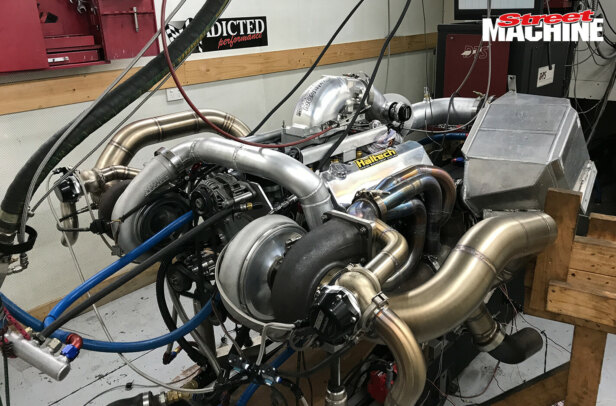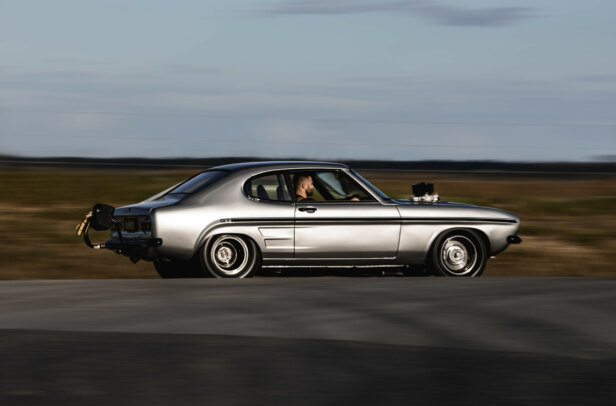Take street tyres, add pump fuel and 200kg of ice and what do you get? Low nine-second passes
This article on Jamie’s Capri was originally published in the May 2007 issue of Street Machine
IT’S probably the fastest legitimate street car in Australia,” reckons proud owner Jamie Farmer. That nine-word sentence is sure to fire up some controversy but he makes some good points in his favour straight off the bat: “There’s no fibreglass, no plastic — it’s a full metal Capri.”
It doesn’t stop there either; take time to really check out this mild-looking Capri. Discounting the two Garrett turbos peeking through the bonnet, the rest of the compact coupe seems pretty tame. Sure, it’s a neat machine but without modified wheel tubs or massive rubber it certainly doesn’t look capable of covering the standing quarter in just 9.30 seconds at 150mph.
But it can. Look at the facts — no tubs, stock leaf springs in their stock locations, all-steel body, 235-section drag radials and pump unleaded fuel, yet it runs those times at that speed. Jamie’s Capri is proof that genuine nine-second streeters do exist and he reckons that it won’t be too long before he’s got it running eights. That would be something to behold — eight second quarters on skinny 235 drag radials and pump unleaded.
With Jamie’s Capri there’s none of the usual ‘just let me bolt my slicks on and fill my nitrous bottle’ crap; it’s ready to go as it stands.
He’s been pretty successful too, winning the street drags at Powercruise 8 in Sydney and the radial tyre class at Queensland’s Streetcar Shootout.
Just don’t go thinking you can bolt a car like this together and expect it to run the same numbers. This car runs so well because it’s been perfectly set up and that didn’t happen over night.
Poking the turbos through the bonnet was necessary because the flipped manifolds that Jamie used originally dictated their positions
“It’d have an easy 250 passes on it,” Jamie reckons, and those passes — split between Jamie and good mate Rick McGavigan — have helped develop the Capri into a finely tuned machine.
When it was completed, back at the end of 2005, the little Capri ran a low 11, slipping and sliding all over the track on its first pass. But with a set of well-adjusted Cal Tracs and some adjustment on the pinion angle, they’ve made those skinny tyres stick.
“I can nail it on the street now and not turn the tyres,” Jamie says. It isn’t just the rear suspension that makes this possible, however — it’s the total package.
Look at the diff ratio; think about it — who runs 3.0:1 ratio gears in anything but a pure street cruiser anymore? But turbo cars just love tall gearing and the taller the gears, the less likely you are to turn the tyres.
Then there’s the way the boost comes on. That’s one of the real secrets in this build.
Jamie leaves the start line at 8psi and runs a maximum of 17psi boost, but it’s the way that the extra 9spi boost is programmed to chime in that helps the Capri maintain traction. Terry Seng, from Paramount Automotive, set the Turbosmart E-boost precisely to monitor and maintain boost pressure all the way down the track. Too much boost too early will ruin the run.
Jamie’s an ex-Queenslander who now runs a business called Cylinder Head Dynamics out Penrith way, west of Sydney, and he’s been building tough street cars for years. When an apprentice had to sell his Capri, Jamie saw the excellent condition of the body and knew that it was an opportunity too good to pass up. Rod’s Restorations, also in Penrith, gave the body an Ultra White freshen-up before Jamie got down to the business of building the twin-turbo small-block.
EFI is the way to go, Jamie reckons. “Just hit the button and it starts and runs fine.” Using internal-wastegate turbos cuts down on plumbing hassles while ACL heatshields protect the paint and hoses
A good old Mexican 302 block, prepped with half-inch studs and a main girdle, has been filled with name-brand gear. SRP forged pistons, Scat H-beam rods and a 4340 Scat crank form a pretty stout bottom end that measures up at 347 cubes. Initially, Jamie used a set of restrictive 289 heads up top and ran 10sec ETs but he dumped them in favour of some heavily ported Kiwi Pro Lightning heads. He’s opened the heads right up to provide the least restriction possible, so the boost builds in the cylinders where it’ll do the most good. Cam specs are something Jamie is understandably keeping secret but he’s specified a custom turbo grind that makes the most of the relatively low boost.
The first thing you see when you lift the bonnet is the polished custom plenum but under it there’s a Ford F150 EFI lower intake. Like the engine, the Garrett roller-bearing turbos are fairly small, but it’s a perfectly matched combination. Originally the turbos were mounted on a set of flipped (swapped from side to side so the exits faced forward) cast iron exhaust manifolds but when they started to crack recently, Jamie made up a set of simple steampipe headers instead.
“That engine is making in the vicinity of 850hp,” Jamie says and given the straight-line performance you’d have to agree he can’t be far off. On the chassis dyno, the Capri has made a bit over 600hp at the tyres. Not too bad considering there’s a Powerglide transmission in the equation.
That’s another reason why this car doesn’t blow the tyres off at the start: with that tall 1.8:1 first gear, the Capri doesn’t exactly leap off the line but boy does it haul arse in the top end. At the track, the 60-foot times are really lazy (for a low-9sec car) with the Capri breaking the beams at 1.44sec. Jamie reckons it’s at the 200-foot mark where the Capri really starts to pile on the speed.
Shell Optimax in the tank on the left, ice in the right and Jamie’s ready to run nines; the only trouble is that the ice has to be replenished after every run
You might have noticed that there’s no big truck intercooler hanging off the Capri’s front bumper, though with 17psi and pump fuel Jamie has to bring those intake temperatures down. He uses a PWR water-to-air intercooler to get the job done. Ice-water sits in a boot-mounted reservoir and is pumped up to the ’cooler, which sits under the passenger side of the dash. Boosted air from the turbos enters and exits through the firewall to pass through the barrel ’cooler on its way to the XF Falcon throttlebody. It works bloody well, too. Jamie says the intake temps only rise 30 degrees C during a full pass. But that performance comes at a price.
“We’ll go through 200kg of ice in a day. I wouldn’t recommend one unless you own a pub!” he says.
Luckily he does; as well as the workshop, Jamie owns the Embassy Hotel in Penrith so he’s got a good supply of ice to support his boost habit.
Jamie’s not the type to sit on a car for too long, though. He’s had his fun with the Capri and while he’d like to see an eight, he’s got other fish to fry and at the time of publish had this ride up for sale. Why? There was an even quicker car on its way from the US and with a shed full of other machinery, he can’t keep it all.
JAMIE FARMER
FORD CAPRI
Colour: Ultra White
GRUNT
Engine: Windsor 347
Manifold: Customised F150
Throttlebody: XF Falcon
Turbos: Garrett GT28/76R 17psi
Heads: Kiwi Pro Lightning, ported
Pistons: SRP 8.8:1 comp
Crank: Scat 4340
Rods: Scat H-beam 5.4in
Cam: CHD Custom turbo grind
ECU: MoTeC M48
Intercooler: PWR barrel
Fuel pumps: Twin Bosch 044
Exhaust: Steampipe log manifolds, twin 3in custom exhaust, twin Hooker Aerochamber mufflers
SHIFT
Transmission: Powerglide, straight-cut planetaries, full manual, transbrake
Converter: The Converter Shop, 3000rpm
Diff: Nine-inch, 3.0:1 full spool
BENEATH
Brakes: XB discs (f), XB drums (r)
Springs: V6 (f), stock leaves with Cal Tracs (r)
Shocks: 90/10 (f), stock (r)
Bushes: Rubber (f), Solid aluminium
INTERIOR
Wheel: GT
Seats: Kirkey aluminium driver’s seat, black vinyl V6 GT interior
Gauges: Auto Meter plus Turbosmart E-boost
Cage: Six-point, mild steel
Shifter: B&M Pro Ratchet
ROLLING
Rims: Weld Prostar, 5×15 (f), 7×15 (r)
Rubber: M/T Sportman (f), M/T Drag radial (r)





Comments